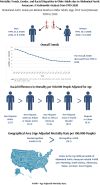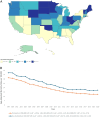Mortality trends, sex, and racial disparities in older adults due to abdominal aortic aneurysm: a nationwide cross-sectional analysis
- PMID: 39806755
- PMCID: PMC11634149
- DOI: 10.1097/JS9.0000000000002114
Mortality trends, sex, and racial disparities in older adults due to abdominal aortic aneurysm: a nationwide cross-sectional analysis
Abstract
Abdominal aortic aneurysms (AAAs) are a significant vascular pathology in older adults, often asymptomatic but with high mortality upon rupture. Despite advancements in diagnostic imaging and surgical interventions, AAAs remain a public health concern. This research letter analyzed CDC WONDER data on AAA-related deaths (ICD-10 I71.3 and I71.4) among US adults aged 65+ from 1999 to 2020. Age-adjusted mortality rates (AAMRs) and annual percent change (APC) were calculated by year, sex, age group, race/ethnicity, geography, and urbanization status. Between 1999 and 2020, there were 180 037 reported deaths in older adults due to AAA. The overall AAMR decreased from 32.6 to 13.2 per 100 000, with a significant decline from 2014 to 2020 (APC: -1.66; 95% CI: -2.48 to -0.48). Older men had a significantly higher AAMR than older women (31.2 vs. 12). Among racial and ethnic groups, Non-Hispanic (NH) Whites had the highest AAMR at 21.7, followed by NH American Indian or Alaska Native (14.5), NH Black (12.6), NH Asian or Pacific Islander (10.1), and Hispanic populations (8.4). Additionally, non-metropolitan areas exhibited higher AAMRs compared to metropolitan areas (23.9 vs. 18.7). While mortality rates have declined, disparities remain, with higher rates among older men, NH Whites, and non-metropolitan residents, highlighting the need for targeted and equitable interventions.
Copyright © 2024 The Author(s). Published by Wolters Kluwer Health, Inc.
Conflict of interest statement
The authors declare no conflicts of interest.
Sponsorships or competing interests that may be relevant to content are disclosed at the end of this article.
Figures




References
-
- Li Z., Lin L., Wu H., et al. . Global, regional, and national death, and disability-adjusted life-years (DALYs) for cardiovascular disease in 2017 and trends and risk analysis from 1990 to 2017 using the global burden of disease study and implications for prevention. Front Public Health. 2021;9:559751. doi:10.3389/fpubh.2021.559751 - DOI - PMC - PubMed
-
- Saeed H, Abdullah MBBS, Naeem I, et al. . Demographic Trends and Disparities in Mortality Related to Coexisting Heart Failure and Diabetes Mellitus Among Older Adults in the United States between 1999 and 2020: A Retrospective Population-based Cohort Study from the CDC WONDER Database. Int J Cardiol Cardiovasc Risk Prev 2024;23:200326. - PMC - PubMed
-
- Mathew G, Agha R, Albrecht J, et al. . STROCSS 2021: Strengthening the reporting of cohort, cross-sectional and case-control studies in surgery. Int J Surg Lond Engl 2021;96:106165. - PubMed
-
- Khan NK, Oksala NK, Suominen V, et al. . Risk of symptomatic venous thromboembolism after abdominal aortic aneurysm repair in long-term follow-up of 1021 consecutive patients. J Vasc Surg Venous Lymphat Disord 2021;9:54–61. - PubMed
MeSH terms
LinkOut - more resources
Full Text Sources
Medical

